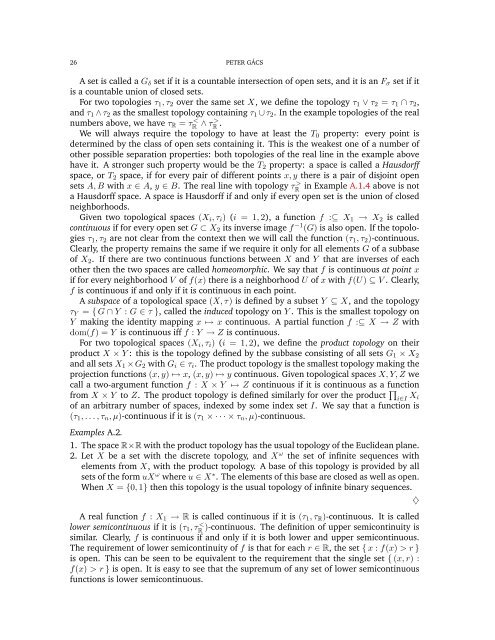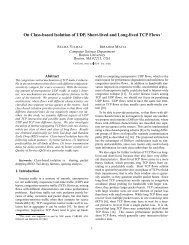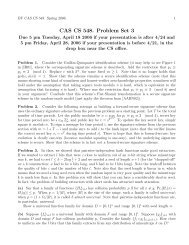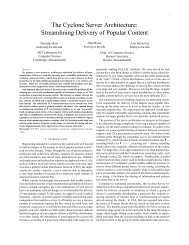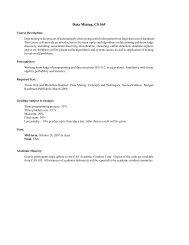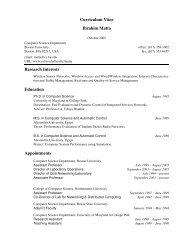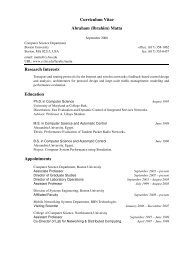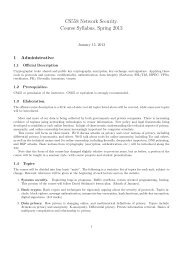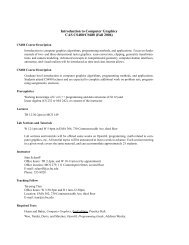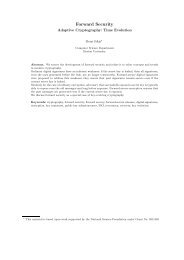uniform test of algorithmic randomness over a general ... - CiteSeerX
uniform test of algorithmic randomness over a general ... - CiteSeerX
uniform test of algorithmic randomness over a general ... - CiteSeerX
You also want an ePaper? Increase the reach of your titles
YUMPU automatically turns print PDFs into web optimized ePapers that Google loves.
26 PETER GÁCS<br />
A set is called a G δ set if it is a countable intersection <strong>of</strong> open sets, and it is an F σ set if it<br />
is a countable union <strong>of</strong> closed sets.<br />
For two topologies τ 1 , τ 2 <strong>over</strong> the same set X, we define the topology τ 1 ∨ τ 2 = τ 1 ∩ τ 2 ,<br />
and τ 1 ∧ τ 2 as the smallest topology containing τ 1 ∪ τ 2 . In the example topologies <strong>of</strong> the real<br />
numbers above, we have τ R = τ<br />
R < ∧ τ R > .<br />
We will always require the topology to have at least the T 0 property: every point is<br />
determined by the class <strong>of</strong> open sets containing it. This is the weakest one <strong>of</strong> a number <strong>of</strong><br />
other possible separation properties: both topologies <strong>of</strong> the real line in the example above<br />
have it. A stronger such property would be the T 2 property: a space is called a Hausdorff<br />
space, or T 2 space, if for every pair <strong>of</strong> different points x, y there is a pair <strong>of</strong> disjoint open<br />
sets A, B with x ∈ A, y ∈ B. The real line with topology τ<br />
R > in Example A.1.4 above is not<br />
a Hausdorff space. A space is Hausdorff if and only if every open set is the union <strong>of</strong> closed<br />
neighborhoods.<br />
Given two topological spaces (X i , τ i ) (i = 1, 2), a function f :⊆ X 1 → X 2 is called<br />
continuous if for every open set G ⊂ X 2 its inverse image f −1 (G) is also open. If the topologies<br />
τ 1 , τ 2 are not clear from the context then we will call the function (τ 1 , τ 2 )-continuous.<br />
Clearly, the property remains the same if we require it only for all elements G <strong>of</strong> a subbase<br />
<strong>of</strong> X 2 . If there are two continuous functions between X and Y that are inverses <strong>of</strong> each<br />
other then the two spaces are called homeomorphic. We say that f is continuous at point x<br />
if for every neighborhood V <strong>of</strong> f(x) there is a neighborhood U <strong>of</strong> x with f(U) ⊆ V . Clearly,<br />
f is continuous if and only if it is continuous in each point.<br />
A subspace <strong>of</strong> a topological space (X, τ) is defined by a subset Y ⊆ X, and the topology<br />
τ Y = { G ∩ Y : G ∈ τ }, called the induced topology on Y . This is the smallest topology on<br />
Y making the identity mapping x ↦→ x continuous. A partial function f :⊆ X → Z with<br />
dom(f) = Y is continuous iff f : Y → Z is continuous.<br />
For two topological spaces (X i , τ i ) (i = 1, 2), we define the product topology on their<br />
product X × Y : this is the topology defined by the subbase consisting <strong>of</strong> all sets G 1 × X 2<br />
and all sets X 1 × G 2 with G i ∈ τ i . The product topology is the smallest topology making the<br />
projection functions (x, y) ↦→ x, (x, y) ↦→ y continuous. Given topological spaces X, Y, Z we<br />
call a two-argument function f : X × Y ↦→ Z continuous if it is continuous as a function<br />
from X × Y to Z. The product topology is defined similarly for <strong>over</strong> the product ∏ i∈I X i<br />
<strong>of</strong> an arbitrary number <strong>of</strong> spaces, indexed by some index set I. We say that a function is<br />
(τ 1 , . . . , τ n , µ)-continuous if it is (τ 1 × · · · × τ n , µ)-continuous.<br />
Examples A.2.<br />
1. The space R×R with the product topology has the usual topology <strong>of</strong> the Euclidean plane.<br />
2. Let X be a set with the discrete topology, and X ω the set <strong>of</strong> infinite sequences with<br />
elements from X, with the product topology. A base <strong>of</strong> this topology is provided by all<br />
sets <strong>of</strong> the form uX ω where u ∈ X ∗ . The elements <strong>of</strong> this base are closed as well as open.<br />
When X = {0, 1} then this topology is the usual topology <strong>of</strong> infinite binary sequences.<br />
A real function f : X 1 → R is called continuous if it is (τ 1 , τ R )-continuous. It is called<br />
lower semicontinuous if it is (τ 1 , τ<br />
R < )-continuous. The definition <strong>of</strong> upper semicontinuity is<br />
similar. Clearly, f is continuous if and only if it is both lower and upper semicontinuous.<br />
The requirement <strong>of</strong> lower semicontinuity <strong>of</strong> f is that for each r ∈ R, the set { x : f(x) > r }<br />
is open. This can be seen to be equivalent to the requirement that the single set { (x, r) :<br />
f(x) > r } is open. It is easy to see that the supremum <strong>of</strong> any set <strong>of</strong> lower semicontinuous<br />
functions is lower semicontinuous.<br />
♦


